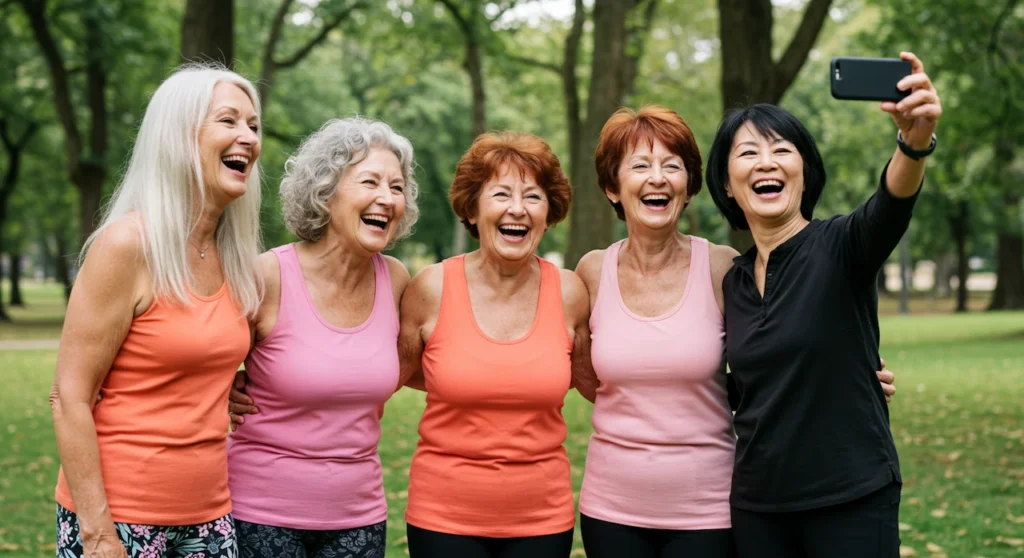Anúncio
What if longevity isn’t just about good genes or chance? What if the secret to living a long, vibrant life lies in plain sight—in the ordinary, often-overlooked things we do every day? Research examining hundreds of women who lived well past 80 revealed a surprising truth.
Anúncio
It wasn’t some magic bullet, exotic diet, or high-tech solution. It was five simple, intentional habits they embraced daily. These women didn’t just survive their later years—they thrived. And the best part? You can incorporate these habits into your own life starting today.

They Moved Every Single Day (But Not How You Think)
Contrary to the polished narratives seen on social media, these long-living women didn’t revolve their routines around intense workouts or structured gym classes. Instead, physical activity was seamlessly integrated into their everyday existence. It wasn’t unusual for them to walk several miles throughout the day—not as part of a fitness regimen, but simply through errands, tending gardens, or visiting neighbors. These types of movements were often spontaneous, unforced, and enjoyable.
Anúncio
Cleaning the house, hanging clothes on a line, sweeping walkways, or even stretching while watching the sunrise were considered natural, not intentional exercise. The key here is consistency. They didn’t go a day without moving their bodies, even in small ways. Importantly, they avoided prolonged sitting. Many would instinctively get up to tidy, shift their position, or step outside after periods of rest. Modern studies support this behavior: frequent movement throughout the day is associated with improved metabolic health, better circulation, and reduced risk of chronic diseases.
Moreover, this organic form of physical activity maintained their flexibility, muscle tone, and balance—all crucial elements for fall prevention and maintaining independence in old age. Their lifestyle was a reminder that it’s not always about pushing harder, but about never fully stopping. Movement, in this context, wasn’t punishment—it was just part of being alive.

They Had Deep Friendships (Not Just Social Media Connections)
In today’s fast-paced, digitally driven world, true connection has become increasingly rare. Many people equate online interaction with social bonding, but the women who lived long, meaningful lives knew better. Their friendships were forged through years of shared experiences—working together, grieving together, celebrating births, and supporting one another through loss. These weren’t casual acquaintances; they were soul-deep connections.
They nurtured these relationships intentionally. Weekly phone calls, afternoon teas, or even handwritten letters were standard forms of communication. They didn’t need an occasion to reach out—they made space in their lives for one another. And when they met, they weren’t just catching up on surface-level news. They discussed fears, offered advice, laughed over memories, and leaned into emotional vulnerability.
Studies have shown that this kind of emotional intimacy strengthens the immune system, reduces the risk of depression, and even lowers blood pressure. In fact, some research suggests that strong social bonds are more predictive of long life than exercise or diet. These women intuitively prioritized companionship as a form of health care.
Importantly, they didn’t measure friendship by quantity but by quality. A few trusted confidantes were more valuable than dozens of acquaintances. In a society increasingly fractured by isolation, these women modeled the essential truth that meaningful friendships can literally help you live longer.
They Ate the Same Foods Their Grandmothers Did
The dietary habits of women who lived beyond 80 didn’t resemble the food fads that dominate today’s media. They didn’t follow calorie-counting apps or experiment with extreme dietary restrictions. Instead, their plates were filled with ingredients familiar to past generations—simple, whole foods grown or raised close to home. This wasn’t nostalgia; it was a nutritional legacy.
Fresh vegetables from their gardens—like kale, cabbage, green beans, or sweet potatoes—often formed the basis of their meals. They used herbs and spices for flavor, rather than sauces laden with sugar or sodium. Meat, when consumed, was typically sourced from local farms or markets, and eaten in moderation. Meals often included fermented foods like sauerkraut, pickled vegetables, or yogurt—providing a natural boost to gut health through beneficial bacteria.
They cooked at home and used traditional preparation methods, from soaking grains to slow-cooking stews. Their meals were both nourishing and deeply satisfying, aligning with modern science that points to the health benefits of the Mediterranean and Blue Zone diets—both of which emphasize whole, unprocessed foods. By avoiding industrialized, packaged goods, these women naturally reduced their intake of trans fats, excess sugar, and artificial additives.
And perhaps most remarkably, they ate mindfully. Meals were not rushed or consumed while distracted. Sitting at a table with loved ones, sharing conversation and laughter, helped to foster a healthier relationship with food. Their diets weren’t just fuel; they were traditions, memories, and expressions of care—all vital ingredients in long-term health.
They Had a Reason to Get Up Every Morning
The concept of “ikigai,” or reason for being, is often cited in discussions about longevity—and these women embodied it. They didn’t wake up to merely fill time; they woke up with purpose. Whether their days involved baking bread for neighbors, organizing a church bazaar, or helping raise grandchildren, they remained vital contributors to their communities. Their roles gave them identity and importance, far beyond retirement.
Even as physical limitations grew, they adapted. A woman who once led a community garden might later tend a few potted plants on her windowsill. Another who had once volunteered at events could still knit scarves for shelters or write thoughtful letters. The drive to serve, create, or nurture never waned—it simply evolved with time.
Psychologists have found that having a sense of purpose contributes to lower levels of stress hormones, reduced inflammation, and slower cognitive decline. It also enhances emotional resilience, which becomes increasingly important as people face the losses and transitions of aging. These women didn’t just “stay busy”—they stayed engaged in a way that made them feel needed.
They didn’t view aging as a decline, but as a phase of life with new potential. Their days had rhythm and intention, anchored by activities that gave them pride and connection. This purpose wasn’t grand or world-changing, but it was deeply personal—and it gave them strength.

They Managed Stress Through Daily Rituals (Not Meditation Apps)
While mindfulness and meditation apps have surged in popularity, women who lived long lives had their own, often quieter ways of coping with stress. These rituals weren’t designed for productivity or performance. Instead, they were deeply personal moments of reflection and release—simple, grounding practices that they returned to day after day.
For many, faith played a central role. Reading scriptures, praying silently, or attending weekly services created a sense of stability and hope. Others found peace in repetitive, creative activities like crocheting, painting, or playing music. These actions allowed their minds to settle and process emotions in a non-verbal, non-judgmental way.
Some would rise early to enjoy quiet moments before the house stirred. Others ended their days by writing in journals or sipping tea on the porch, watching the sunset. The power of these small acts is well-documented. Neuroscientists have found that consistent, calming rituals can help regulate the nervous system, reduce cortisol levels, and increase the production of serotonin and dopamine—neurochemicals linked to mood balance and well-being.
Importantly, these women understood that life was inherently stressful. They didn’t aim to eliminate stress but to manage it so it wouldn’t define them. Their rituals provided emotional safety nets—predictable, comforting habits that created space for healing and reflection. In a world that often glorifies busyness, they offer a timeless lesson: sometimes the most powerful wellness tools are also the simplest.
Conclusion
Living past 80 in good health isn’t a mystery—it’s a mosaic of consistent, thoughtful choices. The women who reached this milestone with vitality didn’t rely on cutting-edge science or strict regimens. They embraced movement as a way of life, nurtured real friendships, ate whole foods, held on to purpose, and kept stress in check through daily rituals.
Their longevity wasn’t luck—it was lifestyle. And while genes and environment play roles, these five habits are powerful levers within our control. It’s not about perfection or radical change. It’s about rethinking the ordinary and choosing the habits that quietly build a life of strength, joy, and resilience.
Remember, this article is for informational purposes only and isn’t a substitute for personalized medical guidance. If you’re considering changes to your lifestyle or health routine, consult with a qualified healthcare provider.
